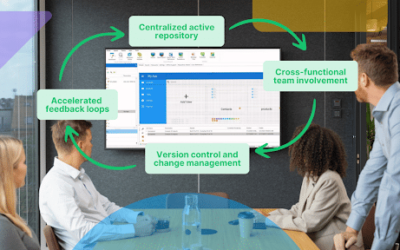Among all the big technology trends popular today, artificial intelligence (AI) is probably the most universally welcomed and praised in the business world. The majority of businesses across industries recognize the enormous potential of this technology and are willing to adopt it as soon as possible.
What are the biggest obstacles to AI implementation?
Even though companies and decision-makers of the business world believe in the AI’s big future and the power of this technology, many of them are not able to start implementing AI just yet. Costs and the lack of high-qualified talent are the main reasons. According to a report by Forbes, 83% of companies say AI is a strategic priority for them today yet, there is not enough data science talent. And 40% of businesses surveyed by Deloitte said that the AI technologies and expertise are too expensive for them to implement at this point.
A widening AI talent gap is probably the biggest challenge for businesses wanting to utilize AI technologies in 2021. As companies are rushing to join the new high-tech innovations race, the demand for all tech specialists has increased with the supply unable to catch up. And in the AI field this is especially the case. According to a report by MMC Ventures, the demand for AI talent has more than doubled in 2018-2019 and continues to increase, with 60% of all AI specialists being absorbed by companies in the technology and financial services sectors. The pool of AI talent, however, remains small. As AI demands advanced competencies in mathematics, statistics and programming; the entry threshold level for this profession is really high and educational institutions aren’t able to produce capable and qualified graduates fast enough to satisfy the business demand.
Why is low-code the gateway to AI for businesses?
And this is where low-code platforms such as LANSA come in. Due to above-mentioned challenges, in the last several years companies were forced to jump on using low-code solutions as a way to build tools and applications that would allow them to utilize the power of AI and other latest tech innovations, quickly and without extensive financial resources.
Low-code platforms turned out to be exactly the solution businesses needed, especially in the time of a significant economic and social turbulence such as the COVID-19 epidemic, when factors like flexibility, rapid customization and scalability play an increasingly important role.
According to a report by Brandessence Market Research (indicating LANSA as one of the key market players), the volume of the global low-code development platform market was $12.85 bln in 2020, and it is expected to reach $65.15 bln by 2027 with a CAGR of 26.1% over the forecast period.
And the need to integrate AI and ML technologies into their daily operations is one of the biggest drivers of rapidly increasing adoption of low-code platforms by companies all around the globe.
What are advantages of low-code AI solutions?
Visual low-code and no-code platforms make AI technologies instantly accessible even to small and medium-sized companies. They allow businesses to build various kinds of custom applications and integrate different elements of AI and machine learning (ML) into them through third-party APIs.
To understand why low-code platforms are undeniably the future of enterprise AI solutions development, let’s look at some of the core advantages of low-code AI compared to the traditional way of development of AI-focused solutions.
- Much lower costs.
Low-code platforms basically enable companies to create fully functional AI-powered solutions without the need to hire expensive AI experts, software developers and other technical specialists. With low-code platforms, the cost of implementation of AI into daily business operations is much lower.
- High accessibility.
Low-code makes AI solutions a lot more accessible on a number of levels, not just the financial. Visual and simple drag-and-drop solutions are more accessible to non-technical people and programming beginners, making AI less complex and thus, less intimidating for them.
- High usability.
Simple user-friendly interface of low-code platforms also allows more people within an organization to collaborate on creation and implementation of a custom AI-powered solution and contribute their perspective to the project, which often results in a more functional and effective final product.
- Quick development and deployment.
Another major advantage of low-code platforms is speed. As they make the whole process of development and deployment of enterprise apps with AI a lot faster, this allows organizations to be more flexible and experiment with different versions or approaches to a problem. Which, again, results in higher quality in the end.
- Great scalability.
Accessing sophisticated AI through third-party APIs also makes your solutions extremely scalable at no additional cost as the server power will automatically increase or decrease according to the current load and needs.
- Gateway to other tech innovations.
Finally, low-code platforms are probably the best way for companies, SMEs especially, to start utilising other high-tech innovations as well, including Big data, IoT (Internet of Things), robotics, embedded systems, and so on. Low-code allows businesses to build solutions combining these and other technologies in a way that would serve their specific needs and requirements.
How to create powerful AI apps with Visual LANSA?
As you may know, Visual LANSA is a powerful development environment pushing the boundaries of what we have traditionally considered as low-code. LANSA allows organizations to build anything from a basic application to handle tasks or send feedback to complex supply chain apps. When it comes to AI, multiple powerful AI solutions can be integrated into apps and tools made in Lansa’s low-code builder by using third-party REST APIs.
Let us give you a few examples of such APIs that can be easily integrated into LANSA solutions.
Able to inspect the given text and identify the prevailing emotional opinion.
Can detect and extract information about entities in an image, across a broad group of categories.
Compares two images and returns a value that tells you how visually similar they are.
Uses machine learning to clarify, sharpen, and upscale the photo without losing its content and defining characteristics.
Applies artistic style to an image quickly by pre-training on specific style examples.
Captions an image by labeling every object the model detects is present within the image.
Analyzes images and videos to detect the presence of adult content, hate symbols, guns, and offensive words.
Allows to colorize black and white images or videos using the image colorization API.
And these are just several examples of available third-party APIs that allow you to integrate powerful AI capabilities into your tools created in LANSA.
To learn more about Visual LANSA and how it can help your business to start utilizing the latest cutting edge technologies today, contact sales.






























